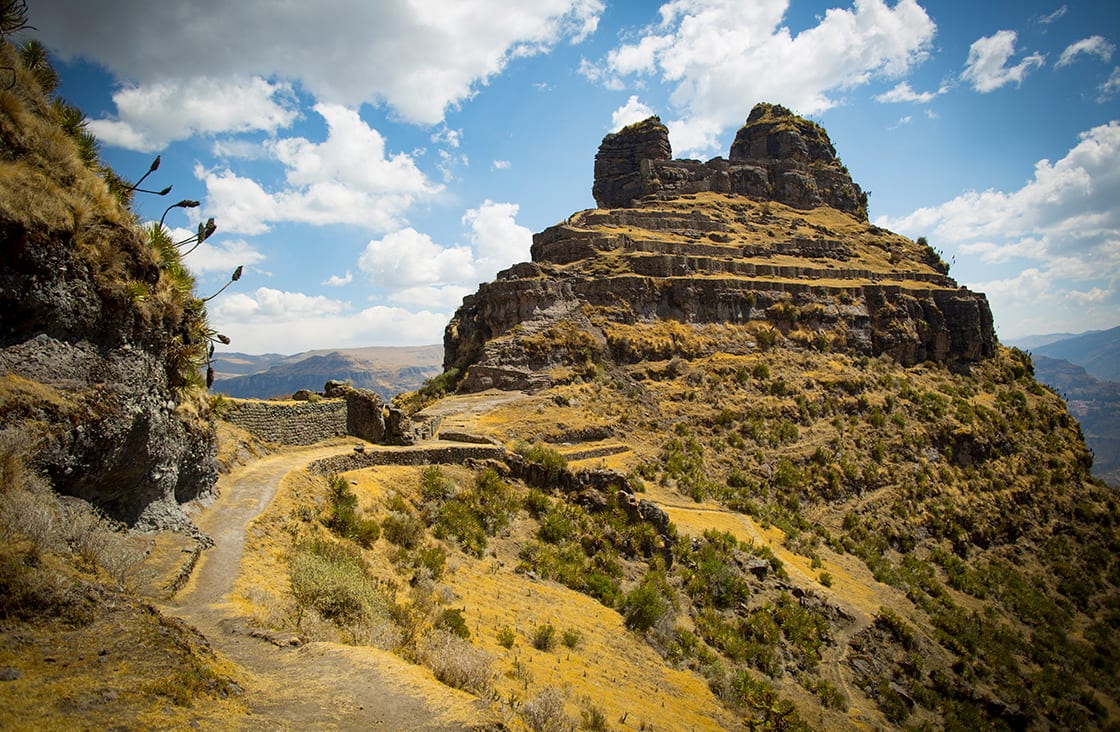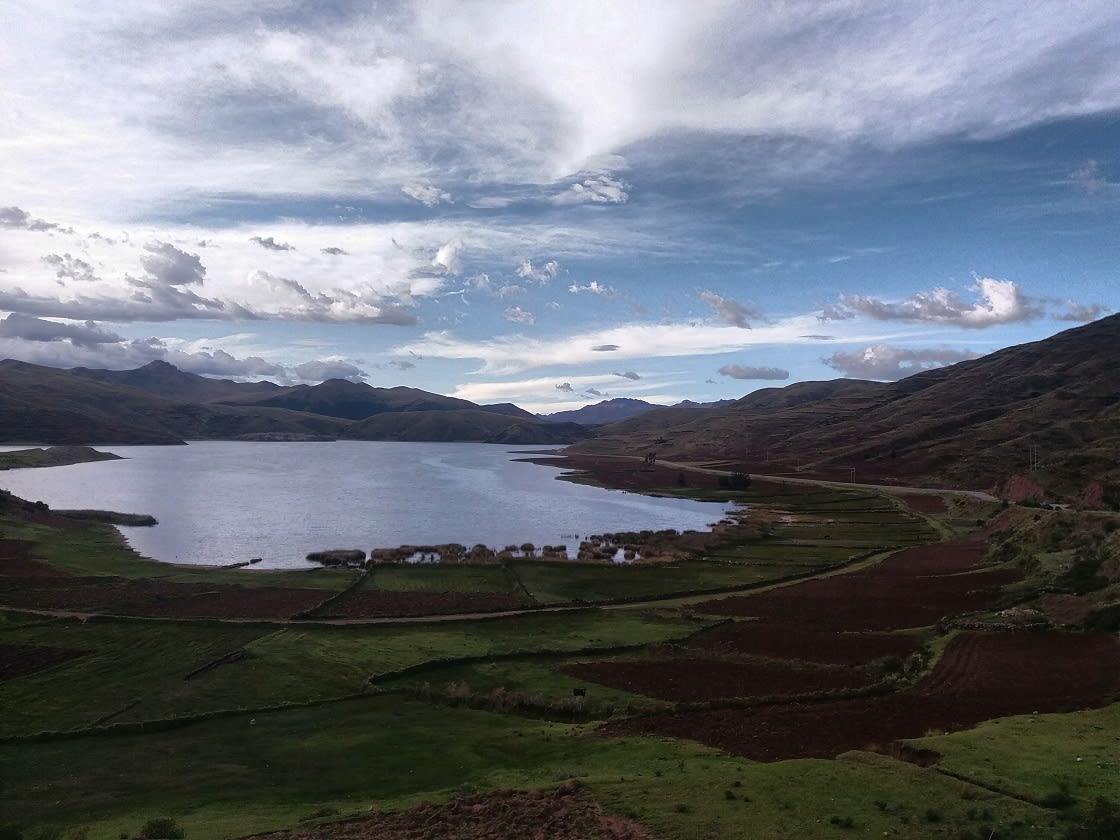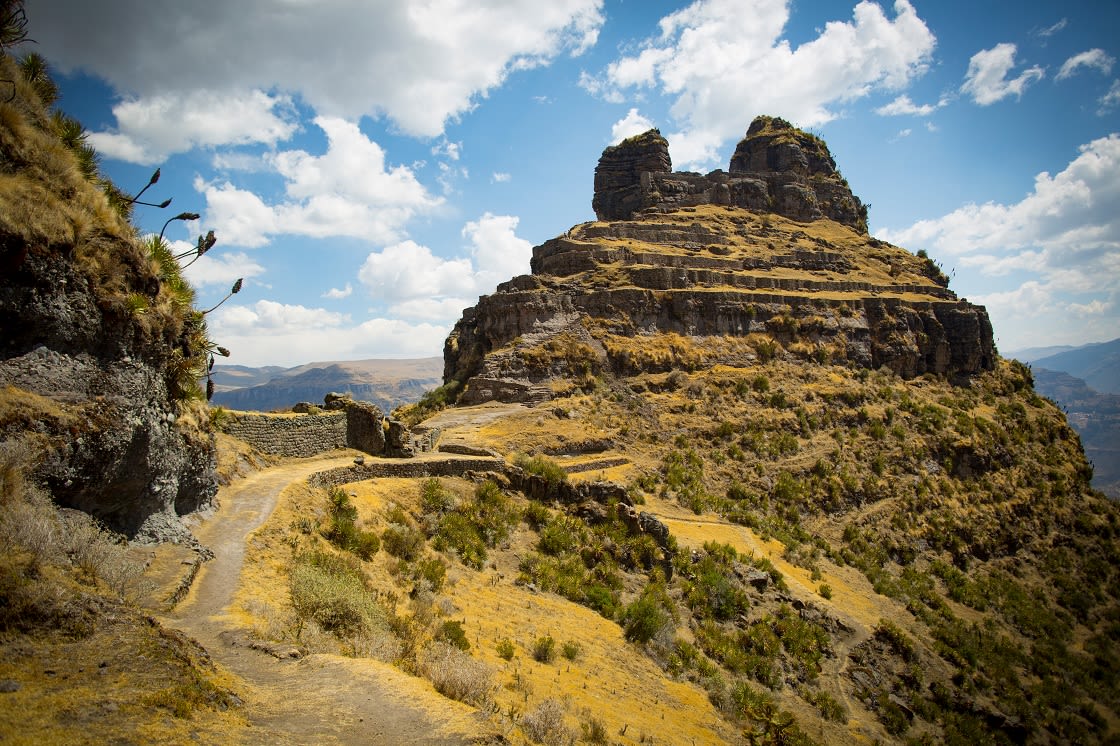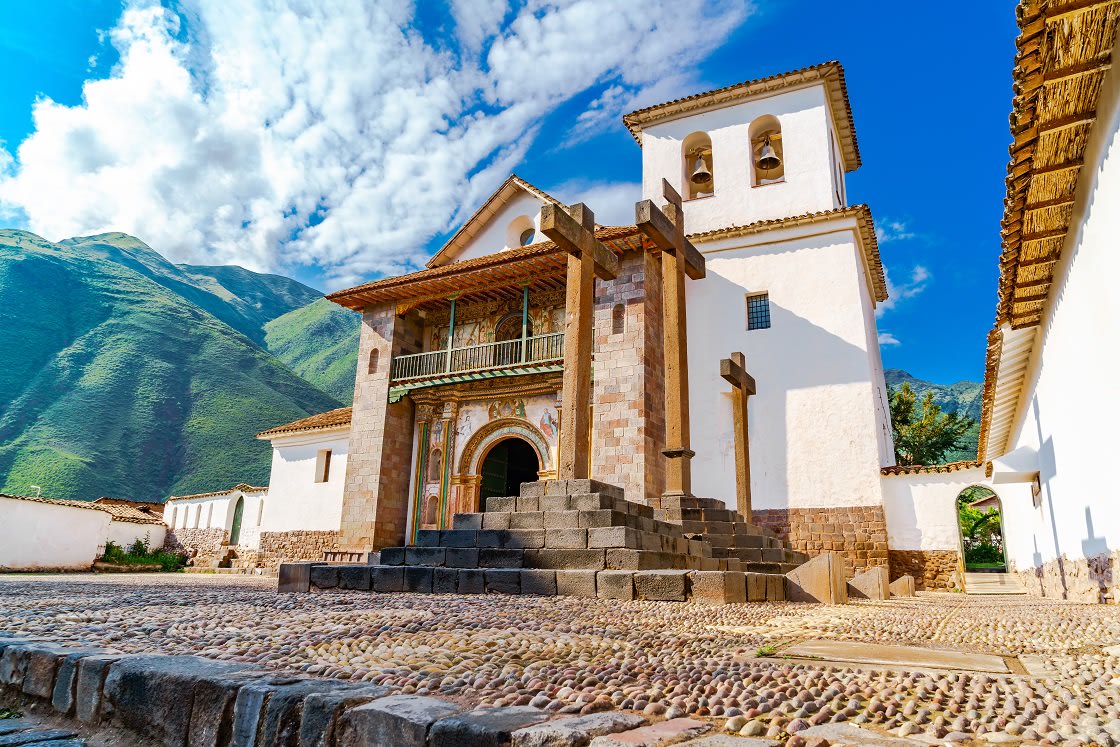
There’s no way anyone could accuse the ancient Inca site of Waqrapukara, Cusco of being over-visited. In fact, most people have never even heard of the place. Hear the words ‘Inca fortress’ and ‘Peru’ in the same sentence, and you’d probably think of Machu Picchu, the world-famous citadel and UNESCO World Heritage Site.
The truth is, Machu Picchu is visited by well over a million tourists each year. So many that UNESCO are considering putting it on the List of World Heritage in Danger because of its precarious future, cable car or no cable car.
Not many people realize that aside from Machu Picchu, there are a handful of lesser-known enigmatic alternatives located in the Cusco region in southern Peru. One of the best of these is Waqrapukara. An awe-inspiring archaeological monument perched high in the mountain peaks above the Apurimac River, Waqrapukara in Peru has only recently been discovered. It was only made a national cultural heritage site as recently as 2017!
There are so many reasons why a full day hike to Waqrapukara makes a unique alternative to visiting Machu Picchu. Read on to learn about this hidden treasure of the Sacred Valley’s southern plateau, its fascinating history and how to get there.
First things first, let’s get to the bottom of the name of the place, as it is quite a mouthful. The name Waqrapukara originates in the Quechua language – “waqra” meaning “horn”, and “pukara” describing a defensive hilltop fortification. So it translates roughly as “horn-shaped fortress” in Quechua. It’s not hard to see how it might have earned this name – the distinct form of the structure looks like a kind of crown sat on top of the mountain peak, or like two prong-shaped horns.
The name is a bit of a riddle, however, as back in the times of the Inca and before, South America was not home to any bulls or cows, or creatures that had horns like this. Cattle were introduced by the Spaniards who didn’t invade until the 16th century. So why would it be named after the shape of a horn?
There is another, more colloquial, the name for Waqrapukara that is used by the locals. “Llamapukara” is used for the site, and offers another interpretation of the citadel’s iconic shape – it could be said to look not like two horns, but like the two upright ears of a llama! This is quite feasible, as llamas were considered sacred animals by the Incas, used for carrying packs, traveling long distances, and they were also sacrificed at significant ceremonies. It wouldn’t be the only historical site likened to the shape of an animal. Machu Picchu is said to be shaped like a bird, and Cusco was built in the shape of a puma. These likenesses would have been deeply symbolic. Some people believe the animal spirits watch over ancient sites like this one, and that it’s the spirit of the llama that is present at Waqrapukara…
When most of us look for travel destinations, there’s a number of factors that reel us in. Some go for spectacular landscapes. Some people prefer a site with incredible history. Others like an adventure. Some try to find somewhere off the beaten track. Somehow, Waqrapukara manages to tick the entire checklist.
The site rises up majestically from a deep ravine at a whopping 4300 meters above sea level (that’s 14,100 ft high). To put this into perspective, the elevation of Machu Picchu is just 2,430 meters (7,970 ft). The peaks of the Andean mountain range stretch out as far as the eye can see, and intense gusts of powerful wind barrel up the canyon below. Far down at the bottom, the winding path of the Apurímac river can be seen carving its path.

Road And Cultivation Near A Lagoon In Acomayo Province
The hilltop, found in Acomayo province, is stepped with wide grassy terraces all the way up, and there’s an ancient stone staircase winding its way up the side. Archaeologically, it’s hard to tell what was carved by humans, and what is a product of geology itself. It’s rare to find yourself somewhere with no other people, but until Waqrapukara gains the renown of sister sites such as Coricancha, Sacsayhuaman, and Ollantaytambo, it will remain untouched by tourists and a place of rare tranquility.
The beauty of Waqrapukara is in its intrigue and mystery – but that does mean that much of the historical fact around the site is fairly speculative. Because it is a pretty recent discovery, the truth behind these stones is still being deciphered, which is very exciting indeed. But what do we know already about this unusual site? How old actually is it, and what was it built for?
We don’t yet know the exact date the fortress harks back to, but it is thought – amazingly – that it predates the Incas by a long way. It’s said that the site was originally a small citadel called Llaqta Pukara built by and for the Qanchi people, possibly in a date range of 1500 to 1000 BC.
During the time of the Inca Empire, specifically during the reign of Wayna Qhapaq, it was conquered and new construction (the one that’s visible today) was built. Historians believe that it was created as a kind of astronomical observatory, together with a sanctuary to the creator god Illa Teqci Pacha Kamaq Wiraqocha.
The Incas had a special skill for blending their structures into the landscape, and this is what makes sites like Machu Picchu and Waqrapukara so breathtaking. At first glance, you might not even spot the artificial bits at all – the buildings are constructed on cliff-faces and precipices, perfectly integrated. The stonework seems to meld seamlessly into the rock formations of the valley, simultaneously celebrating both the natural features and the ceremonial masonry.
The ruins are clustered around the two central towering peaks – the “horns” or “llama ears”. These are surrounded by a cluster of rectangular stone buildings, in which you can find ornamental niches, double and even triple jamb doorways, passages, and ceremonial halls. All of these architectural elements indicate that this was a site of profound significance to the Incas – a special place of ceremony, religion, and political importance too. In between the two horns, there’s a natural cave with a little window that gives an incredible view over the valley. Could this have been a focal point for the astronomical Incas? It certainly would give a fantastic view of the night sky.
Surrounding this hill is a series of eight enclosed terraces, all-around 153 meters in length and 1.8 meters in height, that step their way down the hillside. They’re linked by stone stairways and amazingly preserved walls. In some places, you can see ancient cave paintings of herd animals such as South American camelids like vicuñas, alpacas, and of course llamas – these probably are pre-Incan.
It just shows how much there still is to learn about these ancient places that continue to be uncovered today. Climbing up through the stone terraces and into the crumbling ruins is eerily timeless – you can feel the secrets simmering between the walls.

The Old Andean City Of Waqrapukara
Now we’re onto what you’ve been waiting for – the nitty-gritty of the experience itself. Getting to Waqrapukara is fairly easy, but you do have to be prepared for a bit of a hike. You can either do this by yourself or opt for a tour and take along a well-informed guide. The latter is recommended as the journey is very rural and not well marked. The guide will be able to explain the history of the region, as well as keep you on the right path.
Although we’d urge you to make a concerted effort to allow time for a trip to Waqrapukara in your travel schedule, it’s also an ideal thing to do if you’re in Peru and don’t have much time. A rewarding last-minute activity that you can easily wedge into your itinerary with not much hassle at all because it can be visited as a day trip.
If you don’t want to limit yourself to just one day, you can always unleash your adventurous side and stay the night. The joy of the site is so quiet and unmanaged is that there are plenty of secluded spots to set up a tent and enjoy the crystal clear starry skies of a night in the Peruvian mountains. If camping’s not your thing, there are normally a couple of rooms available with the caretakers of the site, for a very decent fee – they’ll even do you cooked dinner and breakfast included.
The hike to and from Waqrapukara is considered moderate to difficult, and depending on where your starting point is and which trail you take, is somewhere between a 10 and 15 km round trip. Bear in mind, however, that much of the walk is over hilly terrain and the highest point you’ll reach is 4,500 meters above sea level. There is a small entrance fee for the archaeological site.
The journey normally begins in the city of Cusco – which was the heart of the Inca Empire, so a fitting place to start. There are plenty of tours that start in Cusco, normally leaving early in the morning (4 or 5 am). From there, you’ll need to get to either the town of Santa Lucia, or the village of Huayqui (although if you’re using a private guided tour, they may have other departure points). It’s about a 2 and a half hour journey to get to either one by car, but if you’re using public transport you should allow plenty of time and plan all this the day before at least!
Once you’ve got to Santa Lucia or Huayquai, the hike takes either 3 hours or 2 hours respectively, but allow for longer if you want to dawdle along the way! The site itself is about halfway between the two so there are a few different entryways and trails.
The route there is almost as enchanting as the archaeological site itself – panoramic views across mountain and valley scenes, rugged rock formations, and small lagoons with transfixing wildlife along the way. You’ll be ascending as you go (the last part up the steps and into the site itself is particularly arduous) so you’ll want to make sure you’ve got the appropriate gear with you – keep reading for a handy list of things to pack.
Like any adventure, you need to be well-prepared for the journey ahead of you. Peru’s weather can be a bit fickle in the mountains so you should check out the forecast before you embark on the hike. Here’s a checklist to remind you of the essentials to pack:
When you decide to visit Waqrapukara is totally your decision – it is possible to visit the site at any point throughout the year. However, you might want to bear in mind seasonal differences to make sure you choose an optimal time of year to make this once in a lifetime trip. November through to April is the wet season in Peru, and the rainfall can get pretty heavy in the mountains. High rainfall can make hiking particularly tricky, so if you’re not experienced with trekking in the rain, you might want to avoid this risk. Even during the dry season, it’s a good idea to have rain gear with you just in case you get hit by a downfall.
Most would agree that setting off from Cusco early in the morning gives you the chance to spend the morning hiking, and the afternoon enjoying the site itself. If you’re planning on setting up a tent and camping overnight, you’re freer to leave when you choose as there’s no big rush to return. Seeing the sunset over the Andes is unforgettable, and as for the sunrise…
Once you’ve got over the geological marvels of the area, the natural flora and fauna will bowl you over. This part of the world has a unique ecosystem formed by its location between the Amazon and the Andes, so you’re in with the chance of glimpsing some incredible creatures, some of which are particularly endangered. The trail takes you through different ecological zones such as the Andean Valleys and Grasslands, and each level has its own wildlife.
So far as birdlife, the area is home to over 420 varieties and species of bird, making it one of the most diverse areas in the world for our feathered friends. You should keep your eye out for the spectacular Andean condor (which can have a wingspan of up to 130cm), as well as things like the lyre tailed nightjar, the cinnamon flycatcher, the giant hummingbird and of course Peru’s national bird, the Cock of the Rocks.
We already know that llamas have a special role round here, and you can definitely spot them and other camelids roaming the rocks – such as vicuñas, alpacas, and guanacos. The spectacled bear (also known as the Andean bear) is sighted in these parts but sadly their numbers are declining and they are a threatened species.
Add to this list a vast amount of insects, mammals, reptiles, not to mention plants and you will find it hard to keep your eyes on the path ahead! There are an estimated 700 species of butterfly in these mountains, as well as 22 reptile species, 12 amphibians, and 125 arthropods.
There’s no reason why you should stop at Waqrapukara, and turn back to Cusco. This area is full of sites to discover and views to marvel at, so it’s a good idea to look into what other trips you can build into this one. There are several other magical sites that are barely known about even by locals that you could visit on the same trip – Yactapukara, Tambopukara, and Ayapukara are just a selection.

Q’eswachaka The Last Incan Bridge
You could also choose to continue your trip and make it into a two-day excursion by visiting another Inca relic – the incredible Q’eswachaka bridge. This is a rope bridge (also called Queshuachaca or Keshwa Chaca), that is one of the last remaining bridges that were handwoven by the Incas. These braided rope bridges of woven grass were highly regarded by the Incas, and this one measures 36 meters (118 feet) long, suspended 18 meters (60 feet) above the valley floor. Each June, locals from Quechua communities renovate the bridge and hold a spiritual ceremony and festival on the banks of the Apurimac.

The Baroque Church Dedicated To Saint Peter The Apostle Located in Andahuaylillas
Other trips that you could choose to incorporate include the Andahuaylillas and Tipón, or a scenic walk around the “four lagoons” which is becoming more popular locally. Or you could even tie it all in together in the adventure of a lifetime with a Machu Picchu and Amazon Tour.
There’s no doubt that this magical part of the world and the mountains surrounding Cusco in Peru hold many more secrets that we haven’t yet unearthed. The fact that entire archaeological complexes like Waqrapukara are still being discovered is unbelievably exciting – and what an amazing privilege to be able to visit them.
There’s something humbling about this ancient place, clinging to the layers of rock that reflect millions of years of geological construction, fuzed to its man-made crown. It’s the perfect trek for people who want to find somewhere magical and ancient that is also off the beaten track.
While Rainforest Cruises aim to provide accurate and up-to-date information, we make no representations as to the accuracy or completeness of any information herein or found by following any link on this site. Rainforest Cruises cannot and will not accept responsibility for any omissions or inaccuracies, or for any consequences arising therefrom, including any losses, injuries, or damages resulting from the display or use of this information.




